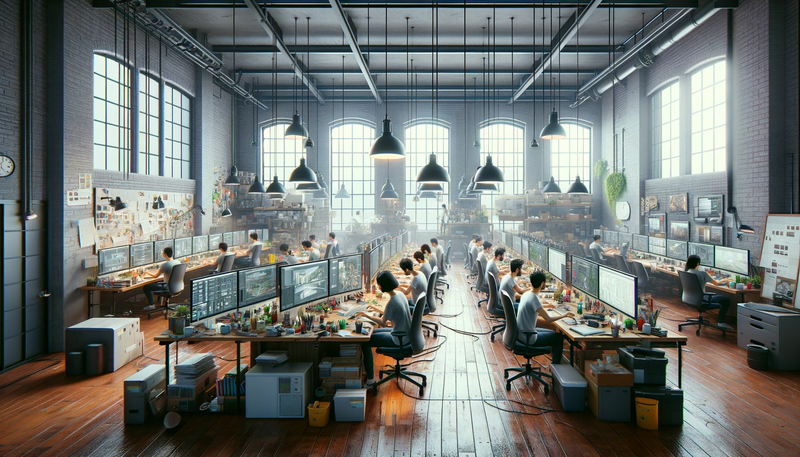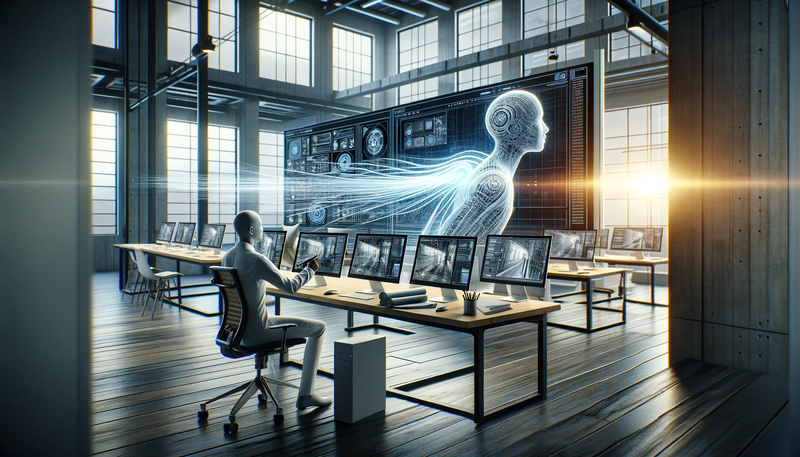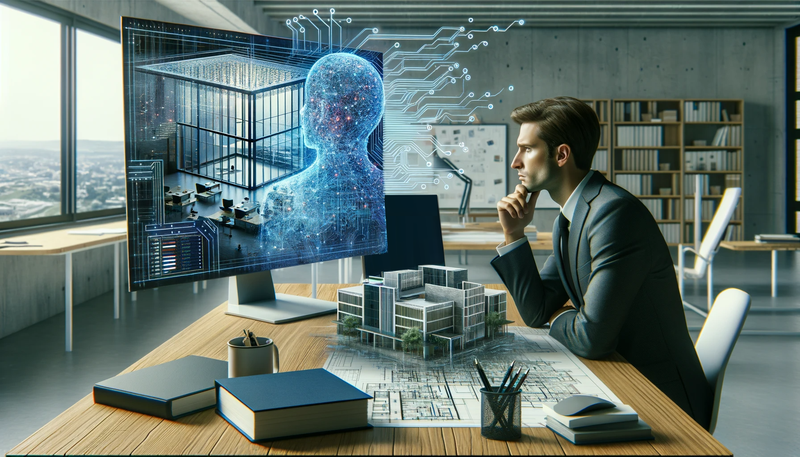Architectural Visualization Revolution: AI-Powered 3D Animation
In the world of architecture, visualization has always been a pivotal tool. Architects and designers use it to convey their vision to clients, stakeholders, and the public, bridging the gap between abstract ideas and concrete structures. For years, 3D architectural animations have been a go-to method for bringing architectural designs to life. These animations help clients and viewers envision the final product and understand how spaces will be used.
However, creating 3D architectural animations has traditionally been a time-consuming and resource-intensive process. Architects and animators have had to invest substantial efforts into modelling, texturing, lighting, and rendering to achieve realistic results. But in recent years, a technological revolution has been brewing in the world of architectural visualization - the integration of artificial intelligence (AI). AI-powered 3D animation is changing the game, making the process more efficient and the results more realistic than ever before. This article explores how AI technologies are transforming architectural visualization, ushering in a new era of efficiency and realism.
The Traditional Challenges of Architectural Animation

Before delving into the impact of AI, it's essential to understand the challenges that architects and animators face in traditional 3D architectural animation. These challenges were significant hurdles to overcome pursuing creating accurate and compelling visualizations.
- Time-Consuming Rendering : Rendering is generating the ultimate image or animation from a 3D model. Traditional rendering methods were slow and computationally intensive, often taking hours or even days to produce a single frame.
- Complexity and Detail : Creating detailed 3D models with intricate textures, lighting, and materials was a painstaking task. Achieving photorealism required substantial manual effort.
- Costs : The costs associated with rendering farms and high-end workstations, as well as skilled animators and designers, added up quickly, making high-quality animations an expensive endeavour.
- Limited Iteration : The time and cost involved in creating architectural animations limited the ability to iterate on designs, which is crucial in the design and feedback process.
AI Revolutionizes Architectural Visualization

Artificial intelligence has brought about a seismic shift in architectural visualization by addressing these challenges and offering innovative solutions. Here are how AI-powered 3D animation is revolutionizing the field:
1. Real-Time Rendering with AI: AI-powered real-time rendering engines has significantly sped traditional rendering methods up. These engines use machine learning algorithms to predict and generate images on the fly, offering photorealistic results at interactive speeds. Architects and clients can now explore different design options and instantly see how changes affect the visual representation.
2. Automated 3D Model Generation: AI algorithms can analyze 2D architectural drawings and auto-generate 3D models with textures and materials. This streamlines the initial modelling process and allows architects to focus more on design creativity.
3. Enhanced Realism: AI-driven algorithms can create highly realistic textures and materials. By analyzing vast datasets of real-world materials, AI can replicate surfaces like wood, concrete, and glass with remarkable accuracy, achieving a level of realism that was difficult to attain manually.
4. Predictive Lighting: AI can simulate how natural and artificial lighting will affect a space. This allows architects and designers to optimize lighting conditions for both aesthetics and energy efficiency.
5. Cost Savings: AI-powered animation reduces the need for extensive human intervention, cutting down on labour costs. Real-time rendering eliminates the need for expensive rendering farms.
6. Iterative Design: With AI-powered visualization, architects can make design changes quickly and easily, encouraging more iterative design processes. This flexibility is invaluable for refining designs based on feedback and evolving project requirements.
7. Immersive Experiences: AI-driven animations can integrate into virtual reality (VR) and augmented reality (AR) experiences. This allows clients and stakeholders to explore architectural designs in immersive environments, gaining a deeper understanding of the space.
8. Data-Driven Decision-Making: AI can analyze data from various sources, such as user behaviour in virtual environments, to inform design decisions. This data-driven approach can lead to more user-centric and efficient designs.
9. Sustainability and Energy Efficiency: AI can simulate the energy performance of buildings, helping architects optimize designs for sustainability and energy efficiency. This is increasingly important as the world seeks greener building solutions.
10. Accessibility: AI-driven animations can be accessible to a broader audience, including those with disabilities, through features like voice commands and screen readers.
11. Global Collaboration: AI-powered tools enable architects and designers to collaborate globally in real-time, facilitating international projects and harnessing diverse talent.
Case Studies: AI in Architectural Visualization
To illustrate the impact of AI in architectural visualization, let's explore a few case studies:
1. Foster + Partners and AI-Generated Floor Plans: Foster + Partners, a renowned architectural firm, collaborated with AI researchers to develop a system that generates optimized floor plans for buildings. The AI algorithm analyzes user needs and preferences and creates floor plans that maximize space utilization and user satisfaction.
2. AI-Enhanced Urban Planning in Singapore: Singapore is using AI to simulate and visualize urban planning scenarios. The city-state leverages AI-powered 3D models to explore various development options, assess environmental impacts, and engage the public in decision-making.
3. AI in Sustainable Design: Architects increasingly use AI to design sustainable buildings. AI algorithms can simulate energy consumption, daylighting, and thermal performance, allowing architects to make informed decisions that reduce a building's environmental footprint.
4. Real-Time Rendering in the Gaming Industry: While not strictly architectural, the gaming industry's adoption of AI-powered real-time rendering has paved the way for similar technologies in architectural visualization. Games like "Cyberpunk 2077" use AI to create stunning, immersive environments in real-time.
Challenges and Ethical Considerations

While AI-powered 3D animation brings significant benefits to architectural visualization, it also raises some challenges and ethical considerations:
1. Data Privacy: AI algorithms rely on vast amounts of data, including architectural plans and user interactions. Protecting this data and ensuring privacy is paramount.
2. Bias and Fairness: AI algorithms can inherit biases from the data they are trained on. Architects and designers must be vigilant to avoid unintentional biases in design recommendations.
3. Job Displacement: As AI automates certain tasks in architectural animation, there may be concerns about job displacement within the industry. However, AI can also enhance job roles and create new opportunities.
4. Technical Expertise: Architects and animators need to gain new skills with AI tools, which can be a barrier for some professionals.
5. Energy Consumption: AI-powered rendering, while faster, can still be computationally intensive and energy-consuming. Designers should consider the environmental impact of AI technologies.
Conclusion
AI-powered 3D animation is propelling architectural visualization into a new era. It offers architects and designers unprecedented efficiency, realism, and creativity in their work. From real-time rendering to automated modelling and sustainable design, AI is transforming the conception of architectural projects, their presentation, and realization.
While challenges and ethical considerations remain, the potential for AI in architectural visualization is vast. It empowers architects to create more sustainable, user-centric, and cost-effective designs. As technology continues to advance, AI will probably become an indispensable tool in the architect's toolkit,
Our Services
View some of our most popular services below.











